| Common name
|
Binomial name
|
Population
|
Status
|
Trend
|
Notes
|
Image
|
| Dwarf ibis
|
Bostrychia bocagei
|
190-2,500[1]
|
CR[1]
|
 [1] [1]
|
Estimate calculated from density and area estimates. Equal to 130-1,700 mature individuals.[1]
|

|
| Northern bald ibis
|
Geronticus eremita
|
200-249[2]
|
EN[2]
|
 [2] [2]
|
Estimate for mature individuals only. Species is considered regionally extinct in Europe.[2]
|

|
| Giant ibis
|
Thaumatibis gigantea
|
290[3]
|
CR[3]
|
 [3] [3]
|
Minimum estimate. Equal to 194 mature individuals.[3]
|
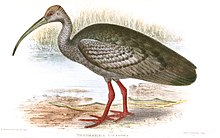
|
| White-eared night-heron
|
Oroanassa magnifica
|
350-1,500[4]
|
EN[4]
|
 [4] [4]
|
Equal to 250-999 mature individuals.[4]
|

|
| Rough-faced shag |
Phalacrocorax carunculatus |
350 – 1500[5] |
VU[5] |
 [5] [5] |
|

|
| Asian crested ibis
|
Nipponia nippon
|
550[6]
|
EN[6]
|
 [6] [6]
|
Equal to 330 mature individuals.[6]
|

|
| Bounty shag |
Phalacrocorax ranfurlyi |
620[7] |
VU[7] |
 [7] [7] |
Minimum estimate.[7] |
|
| White-shouldered ibis
|
Pseudibis davisoni
|
1,000[8]
|
CR[8]
|
 [8] [8]
|
Minimum estimate. Equal to 670 mature individuals.[8]
|

|
| Fasciated tiger-heron
|
Tigrisoma fasciatum
|
1,000-10,000[9]
|
LC[9]
|
Unknown[9]
|
Equal to 670-6,700 mature individuals.[9]
|

|
| Schrenck's bittern
|
Ixobrychus eurhythmus
|
1,000-25,000[10]
|
LC[10]
|
 [10] [10]
|
Equal to 670-17,000 mature individuals.[10]
|

|
| Wattled ibis
|
Bostrychia carunculata
|
1,000-25,000[11]
|
LC[11]
|
Unknown[11]
|
Equal to 670-17,000 mature individuals.[11]
|

|
| Chatham shag |
Phalacrocorax onslowi |
1070[12] |
CR[12] |
 [12] [12] |
|
|
| Pitt shag |
Phalacrocorax featherstoni |
1400[13] |
EN[13] |
 [13] [13] |
|
|
| Australasian bittern
|
Botaurus poiciloptilus
|
1,500-4,000[14]
|
VU[14]
|
 [14] [14]
|
Equal to 1,000-2,499 mature individuals.[14]
|

|
| Flightless cormorant |
Phalacrocorax harrisi |
1679[15] |
VU[15] |
 [15] [15] |
|

|
| Malayan night-heron
|
Gorsachius melanolophus
|
2,000-20,000[16]
|
LC[16]
|
Unknown[16]
|
Equal to 1,300-13,000 mature individuals. Subpopulations include 100-10,000 breeding pairs in Taiwan, and 100-10,000 in Japan.[16]
|

|
| Forest bittern
|
Zonerodius heliosylus
|
2,500-9,999[17]
|
NT[17]
|
 [17] [17]
|
Equal to 1,500-7,000 mature individuals.[17]
|

|
| Madagascar sacred ibis
|
Threskiornis bernieri
|
2,600-3,250[18]
|
EN[18]
|
 [18] [18]
|
Equal to 1,733-2,166 mature individuals.[18]
|
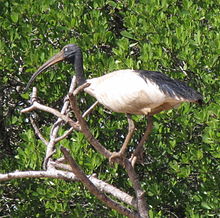
|
| Olive ibis
|
Bostrychia olivacea
|
3,000-45,000[19]
|
LC[19]
|
 [19] [19]
|
Estimate is for mature individuals only.[19]
|

|
| Christmas frigatebird |
Fregata andrewsi |
3600 – 7200[20] |
VU[20] |
 [20] [20] |
|

|
| Black-faced spoonbill
|
Platalea minor
|
3,941[21]
|
EN[21]
|
 [21] [21]
|
Equal to approximately 2,250 mature individuals.[21]
|

|
| Auckland shag |
Phalacrocorax colensoi |
4500[22] |
VU[22] |
 [22] [22] |
|
|
| Bronze shag |
Phalacrocorax chalconotus |
5000 – 8000[23] |
VU[23] |
 [23] [23] |
Numbers may be overestimated.[23] |

|
| Shoebill |
Balaeniceps rex |
5000 – 8000[24] |
VU[24] |
 [24] [24] |
|

|
| Red-billed tropicbird |
Phaethon aethereus |
5000 – 20 000[25] |
LC[25] |
 [25] [25] |
|

|
| Southern bald ibis
|
Geronticus calvus
|
6,500-8,000[26]
|
VU[26]
|
 [26] [26]
|
Equal to 3,300-4,000 mature individuals and 1,650-2,000 breeding pairs.[26]
|

|
| African spoonbill
|
Platalea alba
|
7,300-73,000[27]
|
LC[27]
|
 [27] [27]
|
Estimate is for mature individuals only.[27]
|
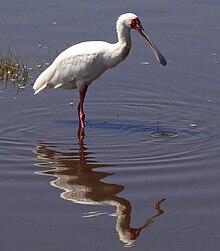
|
| Japanese night-heron
|
Gorsachius goisagi
|
7,500-15,000[28]
|
VU[28]
|
 [28] [28]
|
Equal to 5,000-9,999 mature individuals.[28]
|

|
| Campbell shag |
Phalacrocorax campbelli |
8000[29] |
VU[29] |
 [29] [29] |
Estimate may be dated.[29] |
|
| Bank cormorant |
Phalacrocorax neglectus |
8400[30] |
EN[30] |
 [30] [30] |
|

|
| Crowned cormorant |
Phalacrocorax coronatus |
8700[31] |
NT[31] |
 [31] [31] |
|
|
| Abbott's booby |
Papasula abbotti |
9000[32] |
EN[32] |
 [32] [32] |
|
|
| Madagascar crested ibis
|
Lophotibis cristata
|
10,000[33]
|
NT[33]
|
 [33] [33]
|
Equal to 6,700 mature individuals.[33]
|

|
| Puna ibis
|
Plegadis ridgwayi
|
10,000-15,000[34]
|
LC[34]
|
 [34] [34]
|
Equal to 6,700-10,000 mature individuals.[34]
|
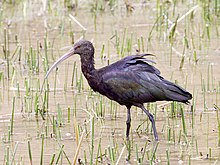
|
| Sharp-tailed ibis
|
Cercibis oxycerca
|
10,000-25,000[35]
|
LC[35]
|
 [35] [35]
|
Equal to 6,700-17,000 mature individuals.[35]
|

|
| Dalmatian pelican |
Pelecanus crispus |
10 000 – 13 900[36] |
VU[36] |
 [36] [36] |
|
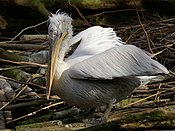
|
| Spot-billed pelican |
Pelecanus philippensis |
13 000 – 18 000[37] |
NT[37] |
 [37] [37] |
|

|
| Black-headed ibis
|
Threskiornis melanocephalus
|
15,000-30,000[38]
|
NT[38]
|
 [38] [38]
|
Equal to 10,000-19,999 mature individuals. Subpopulation estimates include 10,000 in south Asia, 10,000 in south-east Asia, and 100 in east Asia.[38]
|

|
| White-backed night-heron
|
Calherodius leuconotus
|
25,000-100,000[39]
|
LC[39]
|
 [39] [39]
|
|

|
| White-crested tiger-heron
|
Tigrionrnis leucolopha
|
25,000-100,000[40]
|
LC[40]
|
 [40] [40]
|
|
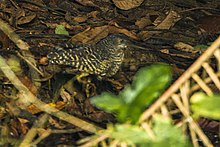
|
| Black-faced ibis
|
Theristicus melanopis
|
25,000-100,000[41]
|
LC[41]
|
 [41] [41]
|
|

|
| Ascension frigatebird |
Fregata aquila |
25 000 – 32 000[42] |
VU[42] |
Unknown[42] |
|
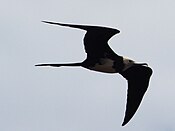
|
| Japanese cormorant |
Phalacrocorax capillatus |
25 000 – 100 000[43] |
LC[43] |
Unknown[43] |
|

|
| Rufescent tiger-heron
|
Tigrisoma lineatum
|
27,700-105,500[44]
|
LC[44]
|
 [44] [44]
|
Equal to 18,000-70,000 mature individuals.[44]
|

|
| Red-legged cormorant |
Phalacrocorax gaimardi |
30 000[45] |
NT[45] |
 [45] [45] |
|

|
| Nazca booby |
Sula granti |
30 000[46] |
LC[46] |
 [46] [46] |
Minimum estimate.[46] |
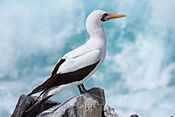
|
| Red-tailed tropicbird |
Phaethon rubricauda |
32 000[47] |
LC[47] |
 [47] [47] |
Minimum estimate.[47] |

|
| Oriental darter |
Anhinga melanogaster |
33 000[48] |
NT[48] |
 [48] [48] |
Minimum estimate.[48] |

|
| White-tailed tropicbird |
Phaethon lepturus |
50 000[49] |
LC[49] |
 [49] [49] |
Minimum estimate.[49] |

|
| Pinnated bittern
|
Botaurus pinnatus
|
50,000-499,999[50]
|
LC[50]
|
 [50] [50]
|
Estimate is for mature individuals only.[50]
|

|
| Agami heron
|
Agamia agami
|
50,000-499,999[51]
|
VU[51]
|
Unknown[51]
|
Calculation may need to be revised. Actual global population may be smaller.[51]
|

|
| Bare-throated tiger-heron
|
Tigrisoma mexicanum
|
50,000-499,999[52]
|
LC[52]
|
 [52] [52]
|
|

|
| Green ibis
|
Mesembrinibis cayennensis
|
50,000-499,999[53]
|
LC[53]
|
 [53] [53]
|
Estimate is for mature individuals only.[53]
|

|
| Eurasian spoonbill
|
Platelea leucorodia
|
63,000-65,000[54]
|
LC[54]
|
Unknown[54]
|
European subpopulation includes 20,400-30,500 mature individuals.[54]
|

|
| Black bittern
|
Ixobrychus flavicollis
|
63,000-320,000[55]
|
LC[55]
|
 [55] [55]
|
Subpopulation at China is 100-100,000 breeding pairs.[55]
|

|
| Pygmy cormorant |
Phalacrocorax pygmeus |
85 000 – 180 000[56] |
LC[56] |
 [56] [56] |
|

|
| Yellow bittern
|
Ixobrychus sinensis
|
100,000-1,000,000[57]
|
LC[57]
|
Unknown[57]
|
|
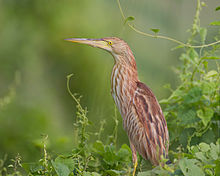
|
| Straw-necked ibis
|
Threskiornis spinicollis
|
100,000-1,000,000[58]
|
LC[58]
|
 [58] [58]
|
|
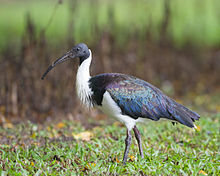
|
| Peruvian pelican |
Pelecanus thagus |
100 000 – 1 000 000[59] |
NT[59] |
 [59] [59] |
|

|
| Socotra cormorant |
Phalacrocorax nigrogularis |
110 000[60] |
VU[60] |
 [60] [60] |
|

|
| Eurasian bittern
|
Botaurus stellaris
|
115,000-340,000[61]
|
LC[61]
|
 [61] [61]
|
European subpopulation includes 75,300-133,000 mature individuals.[61]
|

|
| Cinnamon bittern
|
Ixobrychus cinnamomeus
|
130,000-2,000,000[62]
|
LC[62]
|
 [62] [62]
|
|
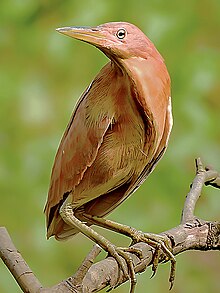
|
| American white pelican |
Pelecanus erythrorhynchos |
180 000[63] |
LC[63] |
 [63] [63] |
|

|
| Brown booby |
Sula leucogaster |
200 000[64] |
LC[64] |
 [64] [64] |
Minimum estimate.[64] |

|
| African sacred ibis
|
Threskiornis aethiopicus
|
200,000-450,000[65]
|
LC[65]
|
 [65] [65]
|
Estimate is for mature individuals only.[65]
|
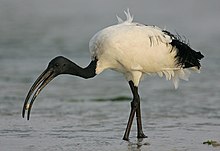
|
| Spot-breasted ibis
|
Bostrychia rara
|
200,000-510,000[66]
|
LC[66]
|
 [66] [66]
|
|
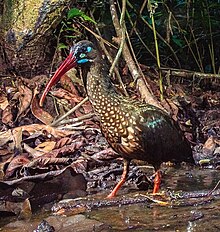
|
| Glossy ibis
|
Plegadis falcinellus
|
200,000-2,300,000[67]
|
LC[67]
|
 [67] [67]
|
This estimate involves the European subpopulation of 56,500-75,400 mature individuals.[67]
|

|
| White ibis
|
Eudocimus albus
|
210,000-360,000[68]
|
LC[68]
|
 [68] [68]
|
Estimate is for mature individuals only.[68]
|
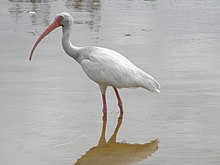
|
| Striated heron
|
Butorides striata
|
260,000-2,300,000[69]
|
LC[69]
|
 [69] [69]
|
Equal to 173,000-1,500,000 mature individuals. Will likely need to be revised under recent taxonomic changes.[69]
|

|
| Red-faced cormorant |
Phalacrocorax urile |
200 000[70] |
LC[70] |
 [70] [70] |
Minimum estimate.[70] |
|
| Cape cormorant |
Phalacrocorax capensis |
200 000 – 250 000[71] |
NT[71] |
 [71] [71] |
|

|
| Cape gannet |
Morus capensis |
300 000[72] |
VU[72] |
 [72] [72] |
Mature population only (~150 000 pairs).[72] |

|
| Squacco heron
|
Ardeola rallodies
|
370,000-780,000[73]
|
LC[73]
|
 [73] [73]
|
European subpopulation estimated at 30,000-51,700 mature individuals.[73]
|

|
| Boat-billed heron
|
Cochlearius cochlearius
|
500,000-4,999,999[74]
|
LC[74]
|
 [74] [74]
|
|

|
| Black-crowned night-heron
|
Nycticorax nycticorax
|
570,000-3,730,000[75]
|
LC[75]
|
 [75] [75]
|
Subpopulations include 120,000-172,000 mature individuals in Europe.[75]
|

|
| Common little bittern
|
Ixobrychus minutus
|
630,000-1,110,000[76]
|
LC[76]
|
 [76] [76]
|
Estimate is for mature individuals only. Further validation is needed.[76]
|

|
| Northern gannet |
Morus bassanus |
950 000 – 1 200 000[77] |
LC[77] |
 [77] [77] |
|

|
| Red-footed booby |
Sula sula |
1 000 000[78] |
LC[78] |
 [78] [78] |
Minimum estimate.[78] |

|
| White-faced ibis
|
Plegadis chihi
|
1,200,000[79]
|
LC[79]
|
 [79] [79]
|
|
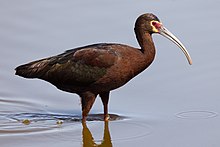
|
| Great cormorant |
Phalacrocorax carbo |
1 400 000 – 2 900 000[80] |
LC[80] |
 [80] [80] |
|

|
| Neotropic cormorant |
Phalacrocorax brasilianus |
2 000 000[81] |
LC[81] |
 [81] [81] |
|

|
| Guanay cormorant |
Phalacrocorax bougainvillii |
2 500 000 – 4 999 999[82] |
NT[82] |
 [82] [82] |
|

|